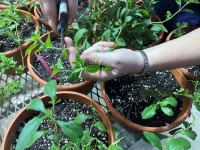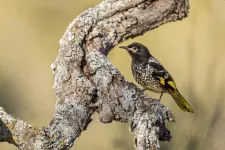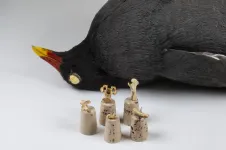(Press-News.org) Scientists at UC San Francisco have detected 109 chemicals in a study of pregnant women, including 55 chemicals never before reported in people and 42 "mystery chemicals," whose sources and uses are unknown.
The chemicals most likely come from consumer products or other industrial sources. They were found both in the blood of pregnant women, as well as their newborn children, suggesting they are traveling through the mother's placenta.
The study will be published March 17, 2021, in Environmental Science & Technology.
"These chemicals have probably been in people for quite some time, but our technology is now helping us to identify more of them," said Tracey J. Woodruff, PhD, a professor of obstetrics, gynecology and reproductive sciences at UCSF.
A former EPA scientist, Woodruff directs the Program on Reproductive Health and the Environment (PRHE) and the Environmental Research and Translation for Health (EaRTH) Center, both at UCSF.
"It is alarming that we keep seeing certain chemicals travel from pregnant women to their children, which means these chemicals can be with us for generations," she said.
The scientific team used high-resolution mass spectrometry (HRMS) to identify man-made chemicals in people.
But, while these chemicals can be tentatively identified using chemical libraries, they need to be confirmed by comparing them to the pure chemicals produced by manufacturers that are known as "analytical standards." And manufacturers do not always make these available.
Recently, for example, chemical manufacturer Solvay stopped providing access to a chemical standard for one perfluorooctanoic acid (PFAS) compound that has emerged as a replacement for phased-out PFAS compounds. The researchers have been using this chemical standard to evaluate the presence and the toxicity of the replacement PFAS.
"These new technologies are promising in enabling us to identify more chemicals in people, but our study findings also make clear that chemical manufacturers need to provide analytical standards so that we can confirm the presence of chemicals and evaluate their toxicity," said co-lead author Dimitri Panagopoulos Abrahamsson, PhD, a postdoctoral fellow with UCSF's PRHE.
The 109 chemicals researchers found in the blood samples from pregnant women and their newborns are found in many different types of products. For example, 40 are used as plasticizers, 28 in cosmetics, 25 in consumer products, 29 as pharmaceuticals, 23 as pesticides, 3 as flame retardants, and 7 are PFAS compounds, which are used in carpeting, upholstery, and other applications. The researchers say it's possible there are also other uses for all of these chemicals.
The researchers report that 55 of the 109 chemicals they tentatively identified appear not to have been previously reported in people:
1 is used as a pesticide (bis(2,2,6,6-tetramethylpiperidini-4-y) decanedioate)
2 are PFASs (methyl perfluoroundecanoate, most likely used in the manufacturing of non-stick cookware and waterproof fabrics; 2-perfluorodecyl ethanoic acid)
10 are used as plasticizers (e.g. Sumilizer GA 80 - used in food packaging, paper plates, small appliances)
2 are used in cosmetics
4 are high production volume (HPV) chemicals
37 have little to no information about their sources or uses (e.g., 1-(1-Acetyl-2,2,6,6-tetramethylpiperidin-4-yl)-3-dodecylpyrrolidine-2,5-dione, used in manufacturing fragrances and paints--this chemical is so little known that there is currently no acronym--and (2R0-7-hydroxy-8-(2-hydroxyethyl)-5-methoxy-2-,3-dihydrochromen-4-one (Acronym: LL-D-253alpha), for which there is limited to no information about its uses or sources
"It's very concerning that we are unable to identify the uses or sources of so many of these chemicals," Woodruff said. "EPA must do a better job of requiring the chemical industry to standardize its reporting of chemical compounds and uses. And they need to use their authority to ensure that we have adequate information to evaluate potential health harms and remove chemicals from the market that pose a risk."
INFORMATION:
Authors: Joining Woodruff and Panagopoulos Abrahamsson in the study were Aolin Wang and Marina Sirota, of UCSF; Ting Jiang, Miamiao Wang and June-Soo Park of the California Environmental Protection Agency; and Rachel Morello-Frosch of UC Berkeley.
Funding: This study was funded by NIH/NIEHS grant numbers P30- 870 ES030284, UG3OD023272, UH3OD023272, P01ES022841, 871 R01ES027051 and by the U.S. EPA grant number 872 RD83543301.
Disclosures: None
About UCSF: The University of California, San Francisco (UCSF) is exclusively focused on the health sciences and is dedicated to promoting health worldwide through advanced biomedical research, graduate-level education in the life sciences and health professions, and excellence in patient care. UCSF Health, which serves as UCSF's primary academic medical center, includes top-ranked specialty hospitals and other clinical programs, and has affiliations throughout the Bay Area. Learn more at https://www.ucsf.edu, or see our Fact Sheet.
Follow UCSF END
CLEVELAND, Ohio (March 17, 2021)--As women age, they are more likely to wake up in the middle of the night to pass urine. The loss of estrogen during the menopause transition accelerates this problem, which is known as nocturia. A new study evaluated the effectiveness of different hormone therapies in managing the frequency of nocturia. Study results are published online today in Menopause, the journal of The North American Menopause Society (NAMS).
The loss of estrogen during menopause has been shown to create bladder dysfunction, sleep disorders, hot flashes, and alterations ...
According to a study conducted at the University of Helsinki, a raw diet from the late stages of suckling to roughly two months of age may reduce the prevalence of inflammatory bowel disease (IBD) in dogs later in life.
In addition, a raw diet administered subsequently up to six months was found to have a positive effect. At the same time, the study indicates that feeding dry food to puppies early on in their lives can increase the incidence of IBD later in life.
In addition to the diet, the maternal history of IBD as well as the dog's gender and age were associated ...
A recent study, affiliated with UNIST has unveiled a novel system, capable of producing hydrogen and electricity quickly and effectively while eliminating carbon dioxide (CO?) emissions significantly.
Published in the January 2021 issue of Nano Energy, this breakthrough has been carried out by Professor GunTae Kim and his research team in the School of Energy and Chemical Engineering at UNIST. In this study, the research team succeeded in developing a membrane-free aqueous metal-CO? battery. Unlike the existing aqueous metal-CO? systems, the new battery is not only easier to manufacture, but also allows continuous operation with one type of electrolyte.
The research team designed ...
Philadelphia, March 17, 2021 - As high school athletes return to practice and games for a variety of sports, the threat of concussions remains. A new study from researchers at Children's Hospital of Philadelphia (CHOP) used head impact sensors in four different sports and studied male and female athletes to determine which of these sports put students at the highest risk for head impacts that could lead to concussions. The findings were published online by the Orthopaedic Journal of Sports Medicine.
"Adolescents are particularly vulnerable to concussion because they frequently participate in sporting and recreational activities and have slower recovery periods compared to adults," said Kristy Arbogast, PhD, senior ...
It's a fact - humans love sugar. For those of us who also like to watch our calories, sugar substitutes can help.
Some zero-calorie or low-calorie sweeteners have attracted bad reputations for containing unnatural ingredients. But there are also natural sweeteners derived from plants, like stevia.
Stevia is hundreds of times sweeter than sugar, and it has no calories. The global stevia market is now worth hundreds of millions of dollars.
The sweetener is derived from the leaves of the plant Stevia rebaudiana, a native of Paraguay and Brazil. The leaves make chemicals similar enough to sugar to trick the tongue. ...
SPOKANE, Wash. - COVID-19 has created new problems for pregnant women in the United States, a group that already faced the highest maternal mortality rate in the developed world even before the pandemic.
One of their biggest concerns is their baby contracting the disease, according to a Washington State University study published recently in the journal BMC Pregnancy and Childbirth. Some women expressed fears that simply going to the hospital to deliver would cause them to get the virus and then be forced to isolate from their newborn.
"Pregnant women are really stressed about contracting COVID-19," ...
Subsidising low carbon emission meals could encourage more people to choose them, according to new research.
The study, led by Queen Mary University of London, investigated the impact of different interventions on encouraging people to select low carbon emission menu options in a simulated lunchtime canteen environment. This included the use of carbon taxes and subsidies, traffic light labelling (TLL) and social norms, where more sustainable options were highlighted as the most popular menu items.
Carbon taxes and either behavioral intervention - TLL or social norms - had a limited effect on shifting behaviours towards meal choices with lower carbon footprints. However, when all these interventions were combined with subsidies, where the ...
The critically endangered regent honeyeater is losing its "song culture" due to the bird's rapidly declining population, according to new research from The Australian National University (ANU).
Just like humans learning to speak, many birds learn to sing by associating with older birds of the same species. They risk losing this skill if adults become too rare. And if they don't learn to sing a sexy enough song, their chances of mating are reduced.
"If endangered birds are unable to learn how to sing correctly, it seriously impacts their ability to communicate," lead author Dr Ross Crates said.
"It ...
Machine learning can be used to comb through online reviews of substance use treatment facilities to home in on qualities that are important to patients but remain hard to capture via formal means, such as surveys, researchers from the Perelman School of Medicine at the University of Pennsylvania show. The researchers found that professionalism and staff dedication to patients were two of the top qualities that could be attributed to either a negative or positive review of the facility. Findings from this study were published today in the Journal of General Internal Medicine.
"Searching ...
GAINESVILLE, Fla. --- In a genetic surprise, ancient DNA shows the closest family members of an extinct bird known as the Haitian cave-rail are not in the Americas, but Africa and the South Pacific, uncovering an unexpected link between Caribbean bird life and the Old World.
Like many animals unique to the Caribbean, cave-rails became extinct soon after people settled the islands. The last of three known West Indian species of cave-rails - flightless, chicken-sized birds - vanished within the past 1,000 years. Florida Museum of Natural History researchers sought to resolve the group's long-debated ancestry by analyzing DNA from a fossil toe bone ...



